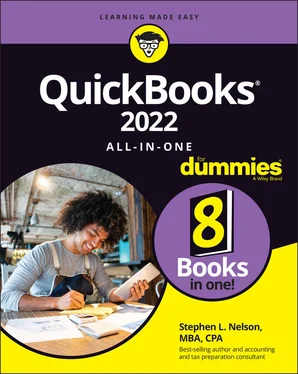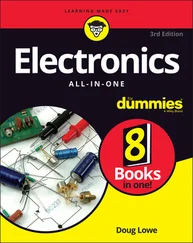 Figuring out how QuickBooks helps
Figuring out how QuickBooks helps
The preceding chapter describes why businesses create financial statements and how these financial statements can be used. If you’ve read Book 1, Chapter 1, or if you’ve spent much time managing a business, you probably know what you need to know about financial statements. In truth, financial statements are pretty straightforward. An income statement, for example, shows a firm’s revenue, expenses, and profits. A balance sheet itemizes a firm’s assets, liabilities, and owner’s equity. So far, so good.
Unfortunately, preparing traditional financial statements is more complicated and tedious. The work of preparing financial statements — called accounting or bookkeeping — requires either a whole bunch of fiddle-faddling with numbers or learning how to use double-entry bookkeeping.
In this chapter, I start by describing the fiddle-faddle method. This isn’t because I think you should use that method. In fact, I assume that you eventually want to use QuickBooks for your accounting and, by extension, for double-entry bookkeeping. But if you understand the fiddle-faddle method, you’ll clearly see why double-entry bookkeeping is so much better.
After I describe the fiddle-faddle method, I walk you through the steps to using and understanding double-entry bookkeeping. After you see all the anguish and grief that the fiddle-faddle method causes, you should have no trouble appreciating why double-entry bookkeeping works so much better. And I hope you’ll also commit to the 30 or 40 minutes necessary to learn the basics of double-entry bookkeeping.
The Fiddle-Faddle Method of Accounting
Most small businesses — or at least those small businesses whose owners aren’t already trained in accounting — have used the fiddle-faddle method. Take a peek at the financial statements shown in Tables 2-1and 2-2. If you’ve read or reviewed Book 1, Chapter 1, you may recognize that these financial statements stem from the imaginary hot dog stand. Table 2-1shows the income statement for the one day a year that the imaginary business operates. Table 2-2shows the balance sheet at the start of the first day of operation.
TABLE 2-1A Simple Income Statement for the Hot Dog Stand
| Sales revenue |
$13,000 |
| Less: Cost of goods sold |
3,000 |
| Gross margin |
$10,000 |
| Operating expenses |
|
| Rent |
$1,000 |
| Wages |
4,000 |
| Supplies |
1,000 |
| Total operating expenses |
6,000 |
| Operating profit |
$4,000 |
With the fiddle-faddle method of accounting, you individually calculate each number shown in the financial statement. The sales revenue figure shown in Table 2-1, for example, equals $13,000. The fiddle-faddle method of accounting requires you to somehow come up with this sales revenue number manually. You may be able to come up with this number by remembering each of the sales that you made during the day. Or, if you prepare invoices or sales receipts, you may be able to come up with this number by adding all the individual sales. If you have a cash register, you may be able to come up with this number by looking at the cash register tape.
TABLE 2-2A Simple Balance Sheet for the Hot Dog Stand
| Assets |
|
| Cash |
$1,000 |
| Inventory |
3,000 |
| Total assets |
$4,000 |
| Liabilities |
|
| Accounts payable |
$2,000 |
| Loan payable |
1,000 |
| Owner’s equity |
|
| S. Nelson, capital |
$1,000 |
| Total liabilities and owner’s equity |
$4,000 |
Other revenue and expense numbers get calculated in the same crude manner. The $1,000 of rent expense, for example, gets calculated by remembering what amount you paid for rent or by looking in your checkbook register and finding the check that you wrote for rent.
The balance sheet values get produced in roughly the same way. You can deduce the cash balance of $1,000, for example, by looking at the checkbook or, in a worst-case scenario, the bank statement. You can deduce the inventory balance of $3,000 by adding the individual inventory item values. You can calculate the liability and owner’s equity amounts in similar fashion.
Some of the values shown in an income statement or on a balance sheet get plugged — meaning that they’re calculated by using other numbers from the financial statement. You don’t look up the profit amount in any particular place; instead, you calculate profit by subtracting expenses from revenue. You can also calculate balance sheet values such as total assets, owner’s equity, and total liabilities, of course.
Okay, I admit it: The fiddle-faddle method of accounting works reasonably well for a very small business as long as you have a good checkbook. So for a very small business, you may be able to get away with this crude, piecemeal approach to accounting.
Unfortunately, the fiddle-faddle method suffers the three horrible weaknesses for a firm that doesn’t have super-simple finances:
It’s not systematic enough to be automated. Now, admittedly, you may not care that the fiddle-faddle approach isn’t systematic enough for automation. But this point is an important one: A systematic approach like double-entry bookkeeping can be automated, as you can do with QuickBooks. This automation means that the task of preparing financial statements requires — oh, I don’t know — maybe five mouse clicks. Because the fiddle-faddle approach can’t be automated, every time you want to produce financial statements, you or some poor co-worker must do an enormous amount of work to collect the numbers and all the raw data necessary to produce information like that shown in Table 2-1and Table 2-2. In reality, of course, with more complicated financial statements, someone does much, much more work.
It’s very easy to lose details. This sounds abstract, but let me give you a good, concrete example. If you look at Table 2-1, you see that the hot dog stand incurs only three operating expenses: rent, wages, and supplies. If you know the operating expense categories that the business incurs, it’s fairly easy to look through the check register and find the check or checks that pay rent, for example. You can use a similar approach with the wages and supplies expenses. But what if you also have an advertising expense category, a business license expense, or some other easy-to-forget category? If you forget a category, you miss expenses. If you forget that you spent money advertising and, thereby, forget to tally your advertising expenses, that whole category of operating expense gets omitted from your income statement.
It doesn’t allow rigorous error checking. This business about error checking may seem to be nitpicky, but error checking is important with accounting and bookkeeping systems. With all the numbers and transactions floating around, errors easily creep into the system. I discuss error checking more later in this chapter, but let me give you an example of the sort of error checking an accounting system can (and should) perform. Take a look at the example of the sales transaction. If you sell an item for $1,000, you can check that amount by comparing it with your record of what the customer paid. This makes sense, right? If you sell me an item for $1,000, you should be able to compare that $1,000 sale with the amount of cash that I pay you. A $1,000 sale to me should correspond to a $1,000 cash payment from me. The fiddle-faddle method can’t make these comparisons, but double-entry bookkeeping can.
Читать дальше

 Figuring out how QuickBooks helps
Figuring out how QuickBooks helps










